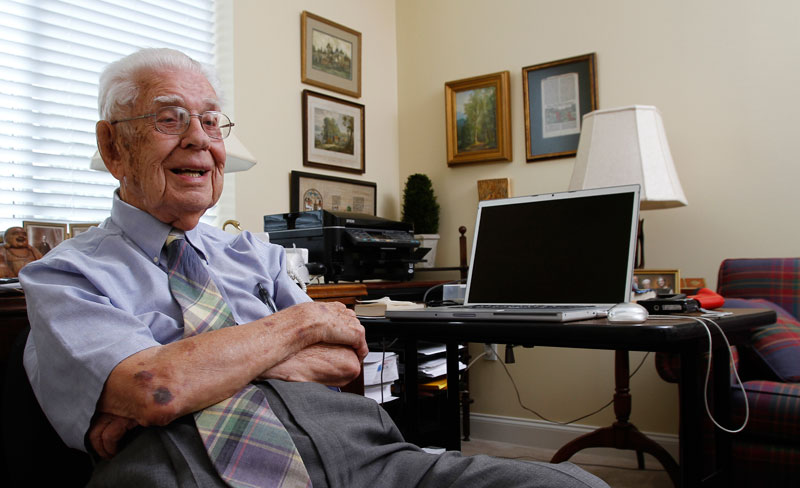A 1936 graduate of UT Knoxville, newsman Walter Pulliam covered major events of the 20th century. Pulliam, who turned 99 in November, lives in Knoxville and enjoys talking about his days as a reporter and editor.
By Fred Brown
After the Japanese bombing of Pearl Harbor in 1941, Walter Pulliam volunteered for the U.S. Army infantry and soon found himself in North Africa.
Trained as an infantry rifleman, he was sent to Oran in North Africa, where his writing skills quickly landed him a clerk’s job in the Allied Headquarters.
“I could type,” he jokes now.
It was there that Pulliam met the late Stanley M. Swinton, then a foreign correspondent with the military’s Stars and Stripes newspaper. Swinton, who would eventually become vice president and director of world services for the Associated Press, was a sergeant at the time, and with his connections, he helped Pulliam snag a transfer to the newspaper.
Right away Pulliam discovered that being a war correspondent was different from his past experience as well as dangerous and that newsmen went to the battle zones right alongside the troops on the front line.
“I thought I would be safer with the Stars and Stripes,” Pulliam says with a chuckle, “but we moved with the troops. I was in more danger then than I was with the infantry.”
War Stories
When he was with the Stars and Stripes Mediterranean edition, Pulliam found himself among the military staff going into towns in Italy and taking over the leading newspapers.
“Then we’d start reporting,” he says.
The resulting news editions would be flown out on military planes and pushed out the back of the aircraft to be distributed to troops on the ground below.
He recalls that once, in Sicily, the reporters moved into a Fascist newspaper office, and the owner refused to give it up to the Americans. But, when an American solider pulled a pistol, the owner quickly changed his mind.
“I thought I would be safer with the Stars and Stripes, but we moved with the troops. I was in more danger then than I was with the infantry.”Once the newspaper was being run by Americans, the news staff immediately began sending out morning editions to troops in Naples, Genoa, Oran, Florence, Milan, Rome and Algiers.
“The Italian newsrooms were pretty much like American newsrooms,” says Pulliam. “We’d replace the Italian staff and bring in our own reporters, printers and circulation people.”
A perk of being on the news staff was that the newsmen got to sleep in an Italian hotel and eat Italian food prepared by an Italian chef.
“One of our staffers was a very ingenious fellow. He set up a bar on the roof of the hotel,” he recalls.
Rome served as a central headquarters for the newspaper, and while stationed there, Pulliam learned of a big story in December 1943.
Even though the media of that era respected the rules of military censorship, there was something about a German attack in the port city of Bari, later dubbed “Little Pearl Harbor,” that piqued the interest of the newsmen.
On the evening of Dec.2, 1943, the port was blown apart by German bombers, which “came in at treetop level and bombed hell out of the place,” says Pulliam.
The attack wasn’t the only surprise that night. One of the U.S. vessels in the harbor, the Liberty Ship SS John Harvey, had been secretly loaded with 2,000 mustard gas bombs, a cargo that even the crew of the John Harvey had no idea was stored in the holds of the ship.
President Franklin Delano Roosevelt and British Prime Minister Winston Churchill, Pulliam says, were convinced that Germany was losing the war but worried the Nazis might resort to chemical warfare. If that occurred, the Allies wanted to be able to react in kind, so they had decided to store the bombs at Bari before moving them farther into Italy.
But, no one counted on Germany’s ability to put together so many bombers at this stage of the war, Pulliam says. In fact, earlier in the day, British Air Vice Marshal Sir Arthur Coningham had held a press conference assuring reporters that the German Luftwaffe had been defeated in Italy and no longer offered a threat to the port or its facilities.
But the port offered the perfect target. “There were 30 ships in the harbor. The place was completely filled with British and American ships,” Pulliam says.
Brilliant floodlights lit up the port as American and British sailors feverishly unloaded the ships. In addition, American military personnel were playing baseball under the lights at a large athletic stadium that had been built by Italian dictator Benito Mussolini before the war.
“The entire city was lighted,” Pulliam recalls.
That night, more than half of 30 ships in the harbor were sunk, and the explosion on the SS John Harvey sent its deadly cargo of mustard gas spurting across harbor waters, mixing with oily fuel. And mustard gas floated over the city like a deadly mist.
 As many as 1,000 military and merchant marine casualties resulted from the attack, but this figure does not include the thousands of citizens of Bari who were exposed to the deadly chemical. Just after the air raid, there was a huge exodus from the city.
As many as 1,000 military and merchant marine casualties resulted from the attack, but this figure does not include the thousands of citizens of Bari who were exposed to the deadly chemical. Just after the air raid, there was a huge exodus from the city.
Pulliam and his newshound buddies found all roads to this story blocked. At the time, they had no idea that the blackout went all the way up the chain to the very top of the U.S. and British governments. Roosevelt and Churchill had ordered suppression of any news about the incident.
At one point, Axis Sally, the propaganda queen for the Axis Powers, broadcasted to the Americans the following message: “I see you boys are getting gassed by your own poison gas.”
Pulliam says it took a Freedom of Information Act request many years after the end of the war to flesh out just what happened that day.
A Lifetime in News
Today, even at the age of 99, Pulliam still has the sharp memory of an outstanding newspaper reporter, so much so his details include the names of people he had known more than six decades ago.
While at the Stars and Stripes, Pulliam had the opportunity to work with giants in media history—Ernie Pyle, whom he had met in Knoxville before the war; Andy Rooney, who later became the icon on the television magazine news show “60 Minutes”; Walter Cronkite, legendary anchorman at CBS; the Associated Press’s Don Whitehead, one of the great foreign correspondents of the war and later a columnist for the Knoxville News Sentinel; and two-time Pulitzer Prize-winning editorial cartoonist Bill Mauldin, who was Pulliam’s roommate for a time.
Pulliam’s career did not stop with the end of the war. In 1945, he scored major interviews with international figures like Pope Pius XII, who gave him a Rosary, and Marshal Josip Broz Tito, the Yugoslav World War II hero who fought with the Allies.
With his typical memory for detail, Pulliam recalls, “Tito had a German shepherd dog with him that he said had been taken from a captured German general. Tito said the dog liked him better than he had liked the German,” Pulliam says.
He says he knew from early childhood that he was destined to become a newspaper reporter. He just didn’t know then how far a career in journalism would take him.
As early as junior high school, Pulliam had become interested in reporting or recording events not only in his own world but also in the broader world he had learned about by reading newspapers and listening to the radio.
Pulliam graduated from Old Knoxville High School in 1932, at the peak of the Great Depression, and then entered the University of Tennessee. Laughing, he recalls that his tuition was something like $30 a quarter. He majored in history and English and graduated in 1936.
“UT had excellent teachers,” he recalls—among them Ruth Stephens, Stanley Folmsbee, J.D. Hoskins and John C. Hodges. “They pushed me along and encouraged me to write.”
Besides providing him with an excellent education, Pulliam says, UT was small enough that “you knew your professors, and they knew you, not only in the classroom, but in person.”
When Pulliam reminisces about his extraordinary life and career, he leans back in his office chair and focuses on distant memories as he sifts through old stories colored by the many major events of the 20th century.
“One thing about Truman, he would say what he thought. I wasn’t nervous asking the president questions. In Washington, he was just like any other politician.”He had begun reporting for The Knoxville Times in the summer after his high school graduation and then worked as a correspondent writing UT news for state newspapers.
While at UT, he also edited the Orange and White, forerunner of The Daily Beacon, and served as a copy editor for the now-defunct Knoxville Journal. And, finally, he was a reporter for the Knoxville News Sentinel, writing police, religion, politics and general news.
In 1938, while in Washington reporting for the News Sentinel, he covered a press conference with Roosevelt, and a year later, he attended the presidential dedication of Chickamauga Dam in Chattanooga.
After returning from his war coverage in 1946, he came home to Knoxville to resume his newspaper career. Not long afterward, he received a job offer from The Washington Post. He worked there first as a reporter and, later, as assistant city editor.
When he covered the White House he was one of only a handful of reporters allowed in the Oval Office to interview both FDR and President Harry Truman.
“One thing about Truman,” Pulliam recalls, “he would say what he thought.”
And, “No,” he says, “I wasn’t nervous asking the president questions. In Washington, he was just like any other politician.”
In the 1950s, Pulliam returned to East Tennessee, purchased the then-weekly Harriman Record and changed it to a daily in 1971. Today, that newspaper holds the distinction of being the smallest U.S. newspaper to publish the entire Watergate Transcript, which amounted to 40 published broadsheet pages.
Over the next few years, Pulliam bought and sold several other East Tennessee newspapers, selling most of them by 1977. He was elected president of the Tennessee Press Association in 1965 and helped start the Tennessee Newspaper Hall of Fame at UT Knoxville.
In 1966, he was awarded the Tennessee Press Association’s Award for service to the newspaper industry. He also became one of the first members of Knoxville’s Society of Professional Journalists and has been a longtime member of the National Press Club of Washington as well as the Washington Post E-Street Club.
Throughout his illustrious career in journalism, Pulliam amassed one of the most eclectic and significant newspaper collections in the state, if not the nation, featuring an assortment of some 700 newspapers dating from the 1600s.
His amazing collection includes the July 8, 1776, edition of Dunlap’s Pennsylvania Packet, which printed the entire Declaration of Independence on its front page, as well as a back-page announcement declaring, “On this day at twelve o’clock, the Declaration of Independence will be proclaimed at the state house.”
His collection also includes several newspapers that were published during the Civil War from both Confederate and Union editors.
Today’s News
Pulliam and his wife, Julia Brownlow Pulliam, a descendant of post-Civil War Tennessee Gov. William Gannaway Brownlow, live in a quiet retirement community in Knoxville.
Reminiscing about his long life and achievements, Pulliam crosses his arms across his chest and stretches his feet out in front of him. His jaw is still as square as it was when he was a keen-eyed reporter so many years ago.
The thrill of being a newspaper reporter, always on the edge of history, continues to delight and interest Pulliam.
“Newspaper work is always interesting,” he says.
But equally interesting is the fellow who reported on some of the most historic events of the 20th century and can still recall details from that era as if it were only yesterday.
– – –
Fred Brown is a retired senior writer at the Knoxville News Sentinel and freelance contributor to the newspaper. He is a member of the E.W. Scripps Co. Hall of Fame and the Friends of Literacy East Tennessee Writers Hall of Fame.



